Walnut doors with stained galss inserts -COMPLETED
Week Ending December 2nd:
I had wanted to complete the kitchen to dining room doors by the end of November and I almost made it. In fact, I completed them this afternoon –which is two days late. Here are two photos of the completed doors, one taken from each room:


I was slowed down because of three separate mistakes. The first of these was that I must have been dozing when I cut the mortises for the hinges on one of the doors, because I cut then into the trim and not into the jamb.


It took considerable time to custom cut little pieces to glue into the holes, glue them into place, sand, and re-finish the trim piece:

I noticed the second problem as soon as I hung the second door.

The gap between the doors was between 12 and 13 millimetres whereas the gap between the two sets of door that I made last year is only 3 to 4 millimetres. I solved this by temporarily removing one of the doors and inserting a lip along one edge. This can been seen in the completed picture taken from the Kitchen side.
Thursday night when I was attempting to re-hang the doors, I encountered a BIG problem.


I had installed the door stops on the door jamb about 3 millimetres to close to the doors. I tried removing this with a cabinet scrapper, with a chisel, and with sandpaper. But, this was taking far too long:
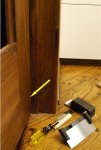
So, I decided to remove the stop strips. They were only “tack” glued and were mainly held in place with screws covered by wood plugs. One problem was that I had no more walnut of sufficient length, so I decided to attempt to remove the stop strips very carefully so that they could be reused. I f
first carved out the wooden plugs:
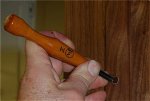
Any doubt that I had about how completely the plugs filled the holes and adhered to the adjacent wood in the jambs and lentil was soon dispelled. It took me a little over two hours to carve out the 13 plugs.T
he utility of Robertson screws was proven yet again. I had used 1 inch #6 screws and, once the plugs were mostly removed it was easy to extract the screws.


Once that was done, the strips came off quickly with the gentle prying of a chisel:





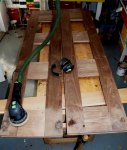

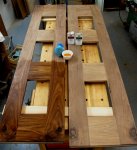
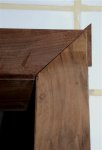
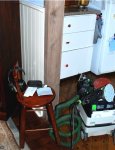



 I had installed the door stops on the door jamb about 3 millimetres to close to the doors. I tried removing this with a cabinet scrapper, with a chisel, and with sandpaper. But, this was taking far too long:
I had installed the door stops on the door jamb about 3 millimetres to close to the doors. I tried removing this with a cabinet scrapper, with a chisel, and with sandpaper. But, this was taking far too long:




 Thanks for sharing the photos and the narrative.
Thanks for sharing the photos and the narrative.